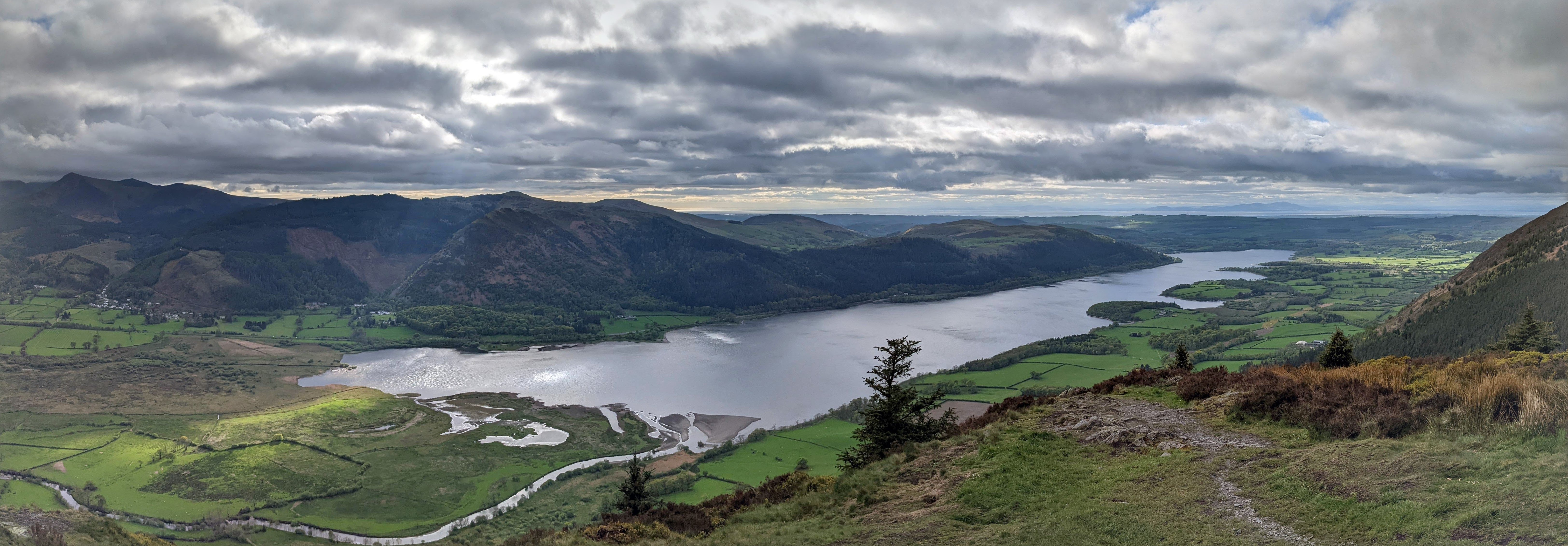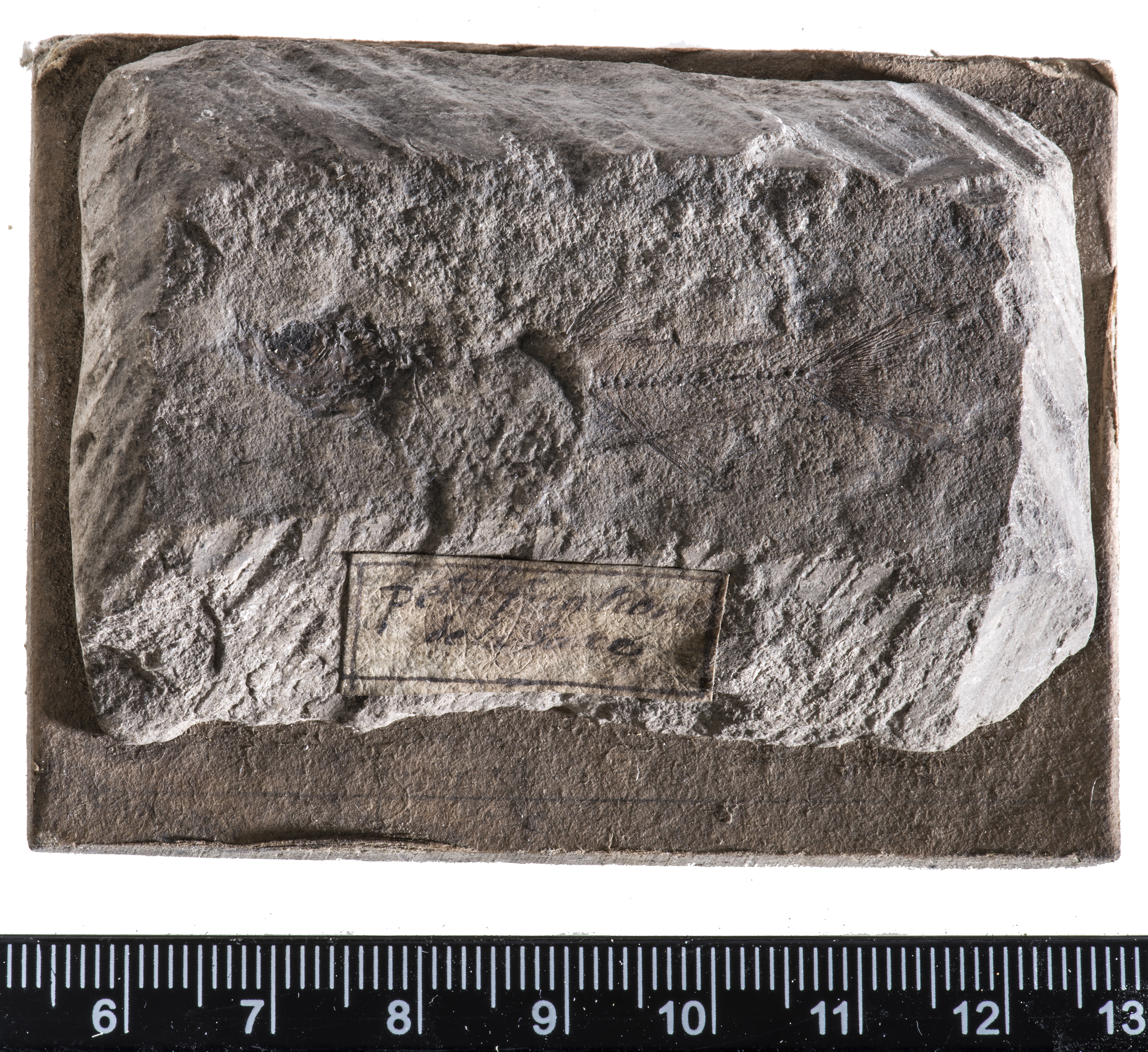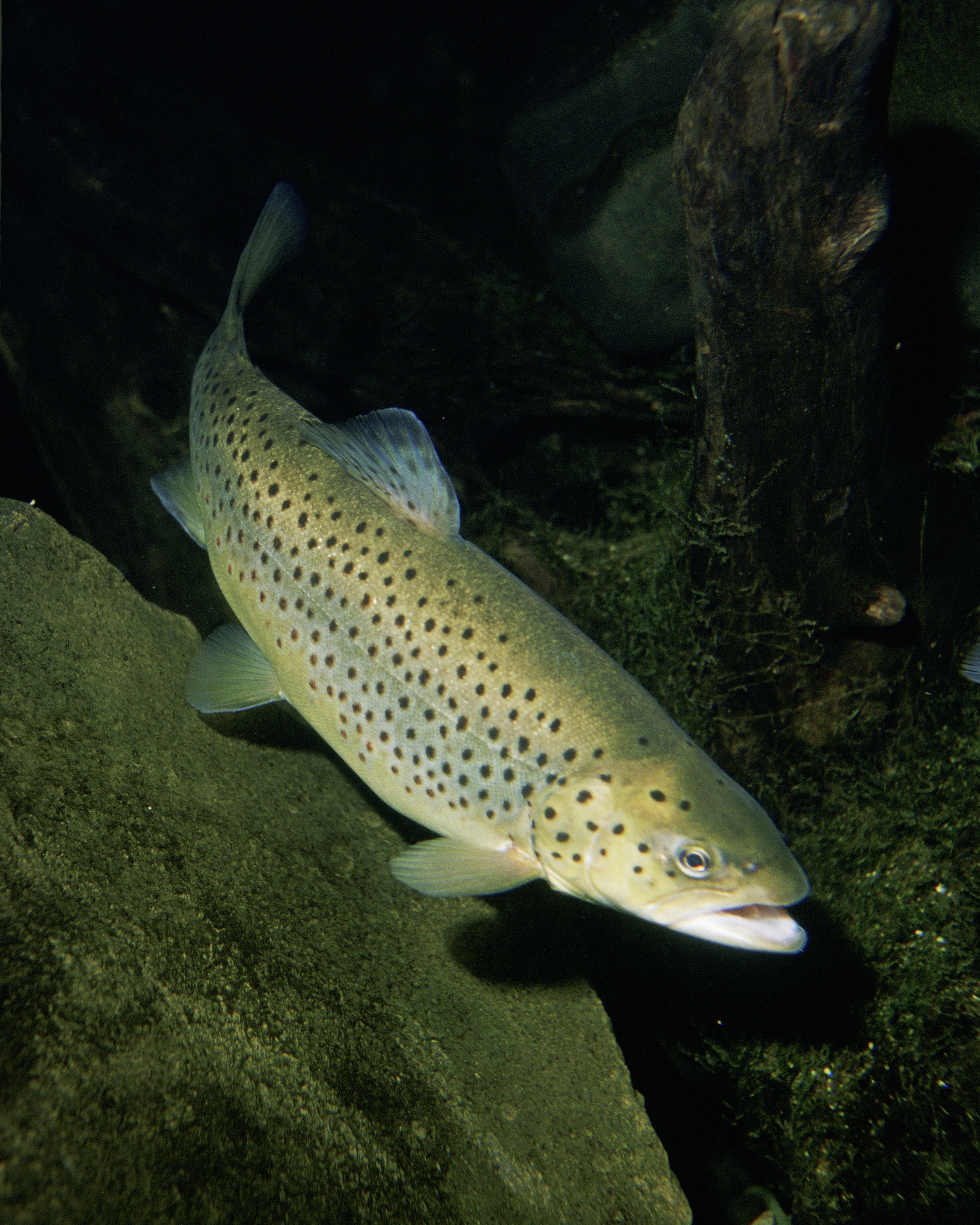|
Bassenthwaite Lake
Bassenthwaite Lake is a body of water in the Lake District in North West England, near the town of Keswick. It has an area of , making the fourth largest of the lakes in the region. The lake has a length of approximately long and maximum width of , a maximum depth of , and a surface elevation of above sea level. Its primary inflow and outflow is the River Derwent, which drains into the Irish Sea at Workington. The lake is in the unitary authority of Cumberland, and the ceremonial county of Cumbria. Bassenthwaite Lake is the only body of water in the Lake District to use the word 'lake' in its name, all the others using the local terms 'water' (e.g. Derwentwater), 'mere' (e.g. Windermere) or '' tarn' (e.g. Dock Tarn). Some maps dating from the 18th century do in fact mark this lake with the name ''Bassenwater'', and the use of the name ''Broadwater'' for this lake is also attested. The A66 dual carriageway runs roughly north–south along the western side of the lake. T ... [...More Info...] [...Related Items...] OR: [Wikipedia] [Google] [Baidu] |
Lake District National Park
The Lake District, also known as ''the Lakes'' or ''Lakeland'', is a mountainous region and National parks of the United Kingdom, national park in Cumbria, North West England. It is famous for its landscape, including its lakes, coast, and mountains, and for its literary associations with Beatrix Potter, John Ruskin, and the Lake Poets. The Lakeland fells, or mountains, include England's List of P600 mountains in the British Isles, highest: Scafell Pike (), Helvellyn () and Skiddaw (). The region also contains sixteen major lakes. They include Windermere, which with a length of and an area of is the longest and largest lake in England, and Wast Water, which at is the deepest lake in England. The Lake District National Park was established in 1951, and covers an area of , the bulk of the region. It was designated a UNESCO World Heritage Site in 2017. National Park The Lake District National Park includes all of the central Lake District, though the town of Kendal, some c ... [...More Info...] [...Related Items...] OR: [Wikipedia] [Google] [Baidu] |
A66 Road
The A66 is a major road in Northern England, which in part follows the course of the Roman road from Scotch Corner to Penrith. It runs from east of Middlesbrough in North Yorkshire to Workington in Cumbria. The road has been progressively improved with dual carriageway sections, but with stretches of single carriageway road. The road is set to be completely dualled between Scotch Corner and Penrith, with a £1.3 billion scheme being announced in March 2024. Route From its eastern terminus between Redcar and Middlesbrough it runs past Stockton-on-Tees and Darlington mainly as two-lane dual-carriageway and single carriageway past Darlington, becoming motorway standard as the A66(M) shortly before meeting junction 57 of the A1(M). It shares the A1(M) route south to Scotch Corner, from where it continues west across the Pennines, past Brough, Appleby, Kirkby Thore, Temple Sowerby and Penrith until it reaches Junction 40 of the M6 motorway at Skirsgill Interchange ... [...More Info...] [...Related Items...] OR: [Wikipedia] [Google] [Baidu] |
Eurasian Minnow
''Phoxinus'' is a genus of freshwater fish in the family Leuciscidae of order Cypriniformes, and the only members of the subfamily Phoxininae, or Eurasian minnows. The other species in this genus are also commonly known as minnows. The name "minnow" was what early English fisherman used to describe "small and insignificant". The genus ''Phoxinus'' is found throughout Eurasia, and includes 21 known species. Previously, members of the North American genus '' Chrosomus'' were also believed to form part of this genus. Species ''Phoxinus'' contains the following species: * '' Phoxinus abanticus'' Turan, Bayçelebi, Özuluğ, Gaygusuz & Aksu, 2023 * '' Phoxinus adagumicus'' Artaev, Turbanov, Bolotovskiy, Gandlin & Levin, 2024 * '' Phoxinus bigerri'' Kottelat, 2007 (Pyrenean minnow) * '' Phoxinus brachyurus'' Berg, 1912 (Seven Rivers minnow) * '' Phoxinus chrysoprasius'' (Pallas, 1814) * ''Phoxinus colchicus'' Berg, 1910. * '' Phoxinus csikii'' Hankó, 1922 (Danube minnow) * ... [...More Info...] [...Related Items...] OR: [Wikipedia] [Google] [Baidu] |
European Perch
The European perch (''Perca fluviatilis''), also known as the common perch, redfin perch, big-scaled redfin, English perch, Euro perch, Eurasian perch, Eurasian river perch, Hatch, poor man's rockfish or in Anglophone parts of Europe, simply the perch, is a predatory freshwater fish native to Europe and North Asia. It is the type species of the genus '' Perca''. The perch is a popular game fish for recreational anglers, and has been widely introduced beyond its native Eurasian habitats into Australia, New Zealand and South Africa. Known locally simply as "redfin", they have caused substantial damage to native fish populations in Australia and have been proclaimed a noxious species in New South Wales. Taxonomy The first scientific description of the river perch was made by Peter Artedi in 1730. He defined the basic morphological signs of this species after studying perch from Swedish lakes. Artedi described its features, counting the fin rays scales and vertebrae of the typ ... [...More Info...] [...Related Items...] OR: [Wikipedia] [Google] [Baidu] |
Pike (fish)
''Esox'' is a genus of freshwater fish commonly known as pike or pickerel. It is the type genus of the family Esocidae. The type species of the genus is '' Esox lucius'', the northern pike. ''Esox'' have a fossil record extending back to the Paleocene. Modern large pike species are native to the Palearctic and Nearctic realms, ranging across Northern America and from Western Europe to Siberia in North Asia. Pike have the elongated, torpedo-like shape typical of predatory fishes, with sharply pointed heads and sharp teeth. Their coloration is typically grey-green with a mottled or spotted appearance with stripes along their backs, providing camouflage among underwater weeds, and each individual pike marking patterns are unique like fingerprints. Pikes can grow to a maximum recorded length of , reaching a maximum recorded weight of 67lb 8oz. Etymology The generic name ''Esox'' (pike fish) derives from the Greek ἴσοξ (''ee-soks'', a large fish) and appears to be cognate wi ... [...More Info...] [...Related Items...] OR: [Wikipedia] [Google] [Baidu] |
Trout
Trout (: trout) is a generic common name for numerous species of carnivorous freshwater ray-finned fishes belonging to the genera '' Oncorhynchus'', ''Salmo'' and ''Salvelinus'', all of which are members of the subfamily Salmoninae in the family Salmonidae. The word ''trout'' is also used for some similar-shaped but non-salmonid fish, such as the spotted seatrout/speckled trout (''Cynoscion nebulosus'', which is actually a croaker). Trout are closely related to salmon and have similar migratory life cycles. Most trout are strictly potamodromous, spending their entire lives exclusively in freshwater lakes, rivers and wetlands and migrating upstream to spawn in the shallow gravel beds of smaller headwater creeks. The hatched fry and juvenile trout, known as ''alevin'' and ''parr'', will stay upstream growing for years before migrating down to larger waterbodies as maturing adults. There are some anadromous species of trout, such as the steelhead (a coastal subs ... [...More Info...] [...Related Items...] OR: [Wikipedia] [Google] [Baidu] |
Salmon
Salmon (; : salmon) are any of several list of commercially important fish species, commercially important species of euryhaline ray-finned fish from the genera ''Salmo'' and ''Oncorhynchus'' of the family (biology), family Salmonidae, native to tributary, tributaries of the North Atlantic (''Salmo'') and North Pacific (''Oncorhynchus'') basins. ''Salmon'' is a colloquial or common name used for fish in this group, but is not a scientific name. Other closely related fish in the same family include trout, Salvelinus, char, Thymallus, grayling, Freshwater whitefish, whitefish, lenok and Hucho, taimen, all coldwater fish of the subarctic and cooler temperate regions with some sporadic endorheic populations in Central Asia. Salmon are typically fish migration, anadromous: they hatch in the shallow gravel stream bed, beds of freshwater headstreams and spend their juvenile fish, juvenile years in rivers, lakes and freshwater wetlands, migrate to the ocean as adults and live like sea ... [...More Info...] [...Related Items...] OR: [Wikipedia] [Google] [Baidu] |
Old Norse
Old Norse, also referred to as Old Nordic or Old Scandinavian, was a stage of development of North Germanic languages, North Germanic dialects before their final divergence into separate Nordic languages. Old Norse was spoken by inhabitants of Scandinavia and their Viking expansion, overseas settlements and chronologically coincides with the Viking Age, the Christianization of Scandinavia, and the consolidation of Scandinavian kingdoms from about the 8th to the 15th centuries. The Proto-Norse language developed into Old Norse by the 8th century, and Old Norse began to develop into the modern North Germanic languages in the mid- to late 14th century, ending the language phase known as Old Norse. These dates, however, are not precise, since written Old Norse is found well into the 15th century. Old Norse was divided into three dialects: Old West Norse (Old West Nordic, often referred to as ''Old Norse''), Old East Norse (Old East Nordic), and Old Gutnish. Old West Norse and O ... [...More Info...] [...Related Items...] OR: [Wikipedia] [Google] [Baidu] |
Bassenthwaite
Bassenthwaite is a village and civil parish to the east of Bassenthwaite Lake in Cumbria, historically part of Cumberland, within the Lake District National Park, England. According to the 2001 census it had a population of 412, increasing to 481 at the 2011 Census. There is a Church of England Church, St John's Bassenthwaite and a tiny Methodist chapel. The village contains many elements of the archetypal English village including a green, primary school and a stream that runs through it. Bassenthwaite is at the foot of Skiddaw, one of the highest mountains in England at . Robin Hood, Skiddaw, Ullock Pike, Longside Edge and Barf can be seen from the village. Part of the parish lies within the Skiddaw Group SSSI (Site of Special Scientific Interest). Location Bassenthwaite is approximately from Bassenthwaite Lake, east of Cockermouth, north of Keswick, south of Carlisle and west of Penrith. Toponymy The name 'Bassenthwaite' is derived from an Old Norse name meaning ... [...More Info...] [...Related Items...] OR: [Wikipedia] [Google] [Baidu] |
Alluvial
Alluvium (, ) is loose clay, silt, sand, or gravel that has been deposited by running water in a stream bed, on a floodplain, in an alluvial fan or beach, or in similar settings. Alluvium is also sometimes called alluvial deposit. Alluvium is typically geologically young and is not consolidated into solid rock. Sediments deposited underwater, in seas, estuaries, lakes, or ponds, are not described as alluvium. Floodplain alluvium can be highly fertile, and supported some of the earliest human civilizations. Definitions The present consensus is that "alluvium" refers to loose sediments of all types deposited by running water in floodplains or in alluvial fans or related landforms. However, the meaning of the term has varied considerably since it was first defined in the French dictionary of Antoine Furetière, posthumously published in 1690. Drawing upon concepts from Roman law, Furetière defined '' alluvion'' (the French term for alluvium) as new land formed by deposition ... [...More Info...] [...Related Items...] OR: [Wikipedia] [Google] [Baidu] |
Derwent Water
Derwentwater, or Derwent Water, is a lake in the Lake District in North West England, immediately south of Keswick. It is in the unitary authority of Cumberland within the ceremonial county of Cumbria. It is the third largest lake by area, after Windermere and Ullswater. It has a length of , a maximum width of , and an area of . Its primary inflow and outflow is the River Derwent, which also flows through Bassenthwaite Lake before reaching the Irish Sea at Workington. There are several islands within the lake, one of which is inhabited. Derwentwater is a place of considerable scenic value. It is surrounded by hills (known locally as fells), and many of the slopes facing Derwentwater are extensively wooded. A regular passenger launch operates on the lake, taking passengers between various landing stages. There are seven lakeside marinas, the most popular stops being Keswick, Portinscale and the Lodore Falls, from which boats may be hired. Recreational walking is a major tour ... [...More Info...] [...Related Items...] OR: [Wikipedia] [Google] [Baidu] |







